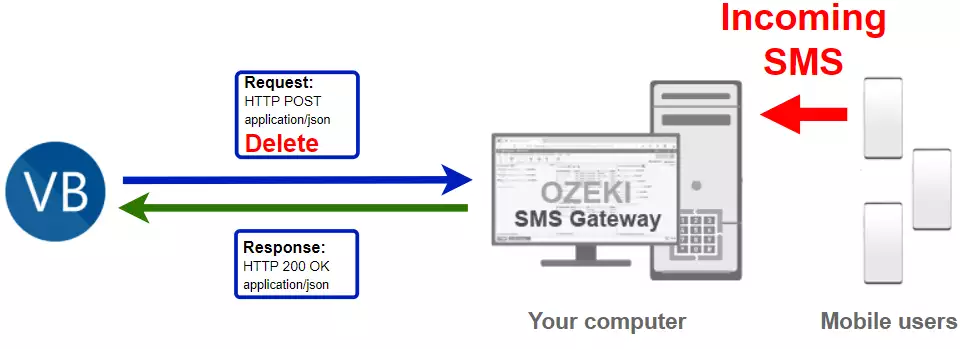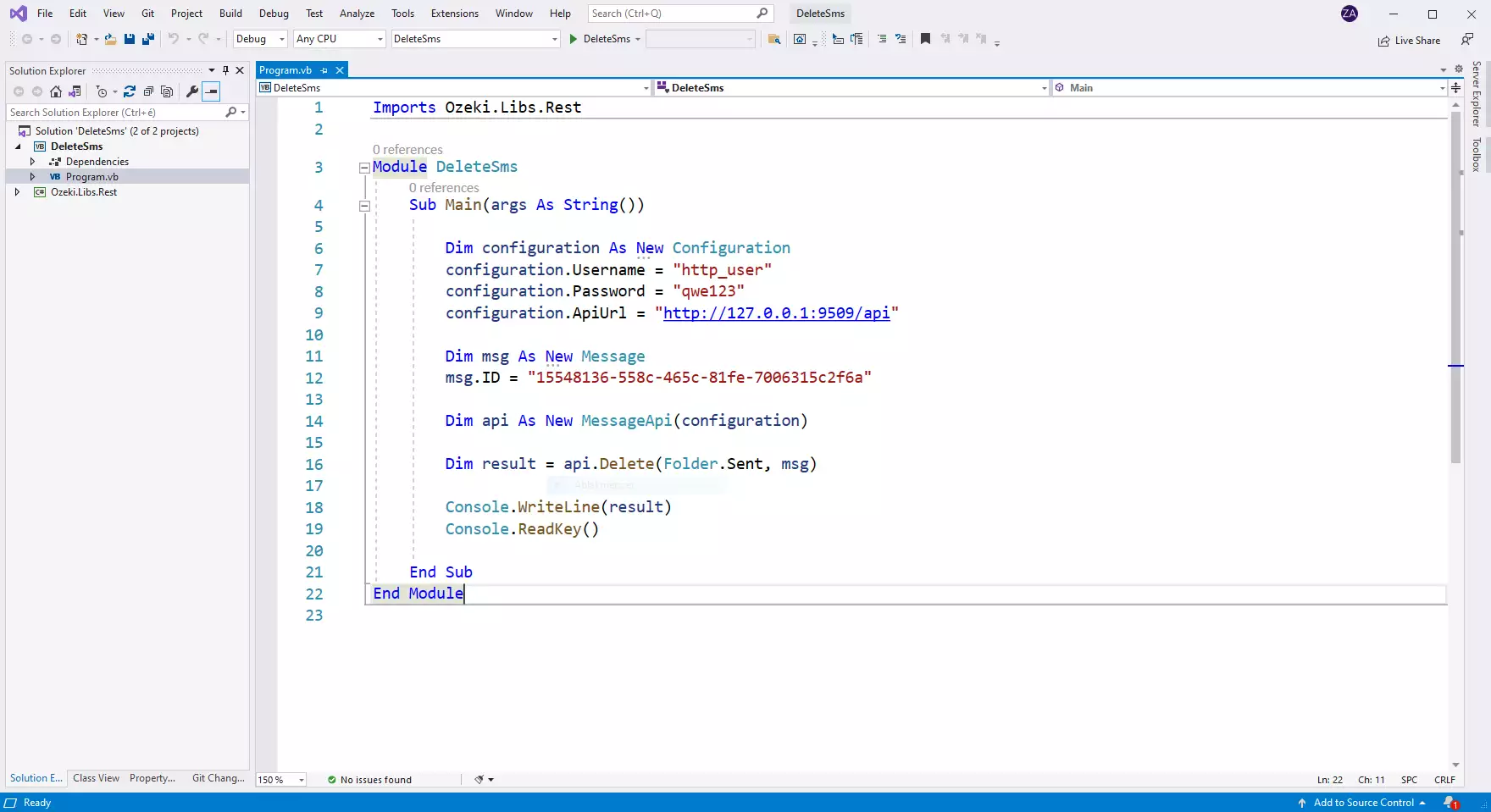How to Delete an SMS in Visual Basic
The simplest way to delete SMS from Visual Basic is to use the built in HTTP/Rest SMS api of Ozeki SMS Gateway. When you use this API, you will send SMS messages by issuing a HTTP Post request to the SMS gateway. The HTTP Post request will contain a message formatted in json format. The SMS gateway will send this SMS to the recipient phone, and it will return a HTTP 200 OK response to your request.

Visual Basic code to delete sms
The Visual Basic sms code sample below demonstrates how you can delete SMS using the http rest sms api of Ozeki SMS Gateway using the Visual Basic Ozeki.Libs.Rest library. This library is provided to you free of charge, and you may use it and modify it in any of your projects.
DeleteSms.vb
Imports Ozeki.Libs.Rest
Module ReceiveSMS
Sub Main(args As String())
Dim configuration As New Configuration
configuration.Username = "http_user"
configuration.Password = "qwe123"
configuration.ApiUrl = "http://127.0.0.1:9509/api"
Dim msg As New Message
msg.ID = "69022e7a-305c-4f01-8063-7f9d65f5ca49"
//You can replace this with the ID of the message you want to delete
Dim api As New MessageApi(configuration)
Dim result = api.Delete(Folder.Inbox, msg)
Console.WriteLine(result)
Console.ReadKey()
End Sub
End Module
How to use the Visual Basic sms example:
This Visual Basic sms example can be used in any .NET or .NET core application. To use it, you must add the Ozeki.Libs.Rest dll as a reference to your project. After the project reference is added, you must put the using Ozeki.Libs.Rest; directive into the header section of your Visual Basic source code. This will allow you to use the classes provided by the Ozeki.Libs.Rest library. You can use the MessageApi class to delete the SMS from the SMS gateway.
Download DeleteSms.vb
The source code explained in this article can be downloaded and used and modified free of charge.
Download: DeleteSms.vb.zip (58.2Kb)
What is in the DeleteSms.vb.zip file?
The DeleteSms.vb.zip file contains the Ozeki.Libs.Rest library, which gives you all the tools necessary to send, mark, delete and receive SMS messages. You will also find the DeleteSms project in the zip, which contains the example code to show you how to send an SMS. This example code is listed below.

How to delete SMS from Visual Basic (Quick steps)
To delete SMS from Visual Basic:
- Install Ozeki SMS Gateway
- Connect Ozeki SMS Gateway to the mobile network
- Send a test sms from Ozeki GUI
- Create a HTTP sms api user
- Start Visual Studio
- Create a solution called DeleteSms.sln
- Add a Visual Basic console project: DeleteSms.vbproj
- Put the code into Program.vb or DeleteSms.vb
- Create a http request to delete the SMS
- Read the HTTP response
- Write the response on the console
- Check the logs in the SMS gateway
Install Ozeki SMS Gateway and create an HTTP API user
To be able to delete SMS from Visual Basic, first you need to install Ozeki SMS Gateway. The SMS gateway can be installed on the same computer, where you develop your Visual Basic code in Visual studio. After installation, the next step is to connect Ozeki SMS Gateway to the mobile network. You can send a test sms from the Ozeki GUI to verify, that your mobile network connection works. The final step to prepare your environment is to create a HTTP sms api user. Create a user with a username of "http_user", and with a password of "qwe123" to make the example work without modification.
After the environment is setup, you can run your Visual Basic code.
HTTP API url to use receive sms from Visual Basic
To delete SMS from Visual Basic, your Visual Basic will will have to issue an HTTP request to the SMS gateway. The API url is shown below. Note that the IP address (127.0.0.1) should be replaced to the IP address of your SMS gateway. If Ozeki SMS Gateway is installed on the same computer where the Visual Basic sms application is running, this can be 127.0.0.1. If it is installed on a different computer, it should be the IP address of that computer.
http://127.0.0.1:9509/api?action=rest
HTTP authentication to use delete sms from Visual Basic
To authenticate the Visual Basic sms client, you need to send the username and password in a base64 encoded string to the server in a HTTP request. The format used is: base64(username+":"+password). In C# you can use the following code to do this encoding:
var encoding = Encoding.GetEncoding("iso-8859-1");
var usernamePassword = username + ":" + password;
var usernamePasswordEncoded = Convert.ToBase64String(encoding.GetBytes(usernamePassword));
For example if you encode the username 'http_user' and the password 'qwe123', you will get the following base64 encoded string: aHR0cF91c2VyOnF3ZTEyMw==. To send
HTTP request header to delete SMS from Visual Basic
To delete the SMS messages, you need to include the following lines as headers in the HTTP request. Note that we include a content type and an Authorization header.
Content-Type: application/json Authorization: Basic QWxhZGRpbjpvcGVuIHNlc2FtZQ==
HTTP request to delete SMS using Visual Basic
To your request the SMS, your Visual Basic application will send an HTTP request similar to the one below. Note, that this request contains a HTTP header part and a http body part. The HTTP body is a JSON encoded data string. It contains the folder name and the ids of the messages.
POST /api?action=deletemsg HTTP/1.1
Connection: Keep-Alive
Content-Length: 73
Content-Type: application/json
Authorization: Basic aHR0cF91c2VyOnF3ZTEyMw==
Host: 127.0.0.1:9509
{
"folder": "inbox",
"message_ids": [
"69022e7a-305c-4f01-8063-7f9d65f5ca49"
]
}
HTTP response received by the Visual Basic sms example
Once the SMS gateway receives this request, it will generate a HTTP response. The HTTP response will contain a status code, to indicate whether the SMS submit request was successful or not. It will also return a JSON encoded structure to provide you useful details about the message's submission.
HTTP/1.1 200 OK
User-Agent: OZEKI 10.3.116 (www.myozeki.com)
Content-Type: application/json; charset=utf8
Last-Modified: Thu, 10 Jun 2021 11:02:26 GMT
Server: 10/10.3.116
Transfer-Encoding: chunked
{
"http_code": 200,
"response_code": "SUCCESS",
"response_msg": "",
"data": {
"folder": "inbox",
"message_ids": [
"69022e7a-305c-4f01-8063-7f9d65f5ca49"
]
}
}
Visual Basic sms example: DeleteSms.sln
How to download the project file (Video tutorial)
In this video, you will learn how to download and run the DeleteSms.sln example project. The video will start with the download page and will end with the opened project. We will show you how to download and open the project file. The video is only 58 seconds long, but it has all the information you need to do the task. You can start the downloading process from the tutorial page.
The example code below is part of the DeleteSms.sln Visual Studio Solution. A visual studio solution can contain multiple projects and multiple files. In this solution there are only two projects: DeleteSms.vbproj, Ozeki.Libs.Rest.csproj, and one file: Program.vb.

How to use the example project (Video tutorial)
In the next video, you will learn how to run the example code and how to check the log of the process. It will start with launching the Ozeki SMS Gateway and will take you all the way to the empty inbox folder where the messages were deleted from. You will learn how to check the log page and how to get the message ID that you need for the delete process. The video is only 1 minute long and very detailed. After watching it, you will be able to perform the task on your own. We use the Ozeki SMS Gateway to watch the Events tab and see the details of the messages. The Ozeki SMS Gateway offers great user experience due to the very intuitive interface and the versatility.
Runing the Visual Basic sms example on Windows
When you use windows to run this sms example written in Visual Basic, you will notice that you get slightly better performance, than when you run it on Linux. To understand why this happens, you must bring into mind that Visual Basic is using the .NET framework for code execution. This is because the .NET implementation on Windows is optimized for performance, while mono, the .NET implementation on Linux has some catching up to do in this field.
Conclusion
The guide above showed the steps of SMS deleting in VB using Ozeki SMS Gateway. If the description was read carefully, removing unwanted messages from your inbox can be very simple. Ozeki SMS Gateway is very reliable and can be managed very easily, even if you want to control the program with VB codes.
It is really important to delete SMS from the inbox to save storage. Being familiar with VB helps to understand this process, but as you could see, it is not a hard procedure even for those who are new to VB programming.
Make sure that you don't finish the reading here, more can be read about topics like SMS scheduling and receiving in VB on Ozeki's tutorial page.
Now your only thing to do is to download Ozeki SMS Gateway and let the work begin!
